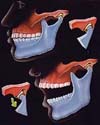
TMJ is classified as a joint dysfunction. TMJ occurs when the joints that connect the jaw to the skull are out of alignment. Temporomandibular joints (TMJ) connect the lower jaw on the skull. By hitting the joint head to the joint disc unequally, you put force to the whole joint. It causes TMJ. Symptoms include jaw clicking and pain, and difficulty in opening the mouth.
Because TMJ is classified as a joint dysfunction, an oral surgeon usually performs a treatment. Treatments include myo-monitor, which gives electronic stimuli to the joint, splints (bite plates), and joint surgery. Many people might already have used a splint since a general dentist can easily make one. However, it is difficult to treat TMJ completely in many cases.
There are various views as to the causes of TMJ. In many cases, however, a malocclusion (bad bite) puts extra stress on the joint, because a lower jaw has moved unequally.
![]() Lower jaw is shifted either left or right.
Lower jaw is shifted either left or right.
Because the lower jaw is shifted, the joint gets extra stress. You can easily check this by yourself. Looking at yourself in a mirror with clenched teeth, examine the central lines of the upper teeth and lower teeth. If the line is not straight and shifted in either direction, you may have TMJ.
![]() Upper and lower teeth occlusion drops.
Upper and lower teeth occlusion drops.
Because upper and lower teeth occlusion drops, the lower jaw shifts backward and the joint gets extra stress. You can also check this by yourself. Looking at yourself in a mirror with clenched teeth, examine how your upper and lower teeth fit together. Normally, 1/3 of lower teeth are hidden by upper teeth and 2/3 of the teeth can be seen. If lower teeth occlusion drops, more than 2/3 of lower teeth are hidden by upper teeth.
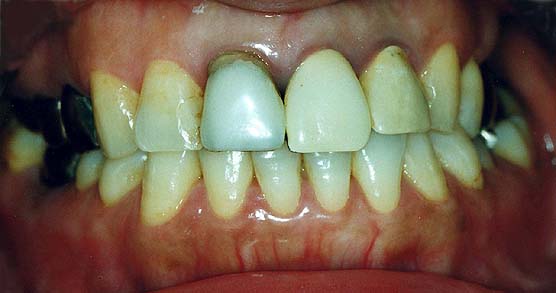
This Photograph shows a patient who could not open her mouth. In this case, there were two causes lower jaw shift and dropped occlusion. The central line of lower teeth was shifted to right-hand side, and the length of the upper front teeth was short. That is, the lower jaw was shifted to the left unequally causing extra stress on the left jaw joint. The cause of the lower jaw shift was upper teeth fillings. Because there were a lot of fillings with unsuitable height and shapes, the lower jaw was gradually shifted to the left and top.
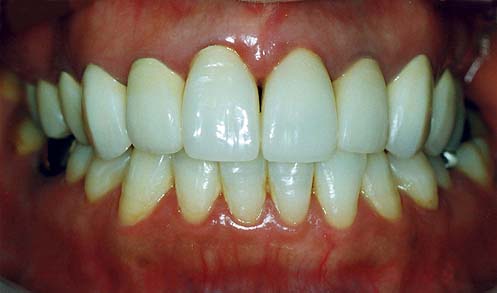
The second photograph shows the mouth after the treatment. All of the upper teeth filings were replaced with ceramic crowns. By correcting the occlusion, the lower jaw was shifted back to the right. Although the central lines were not completely straight on the photograph, the height of occlusion was improved, thereby alleviating the TMJ.

This patient sought straightening the front teeth. She heard clicking sound from the left jaw, and felt severe pain in the left shoulder. That was resulted from the shifted lower jaw because left and right fillings were uneven. The left side of face was slightly stuck out.

The front teeth and old fillings were replaced with GES crowns. The occlusion was also shifted back to the right. Because the lower jaw was corrected, the jaw joint clicking and the shoulder pain disappeared. Asymmetrical face was also corrected.
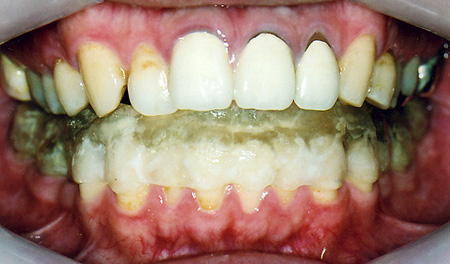
This patient had worn a hard mouthpiece to treat TMJ for a long time. As a result, the all teeth sunk into the gums.

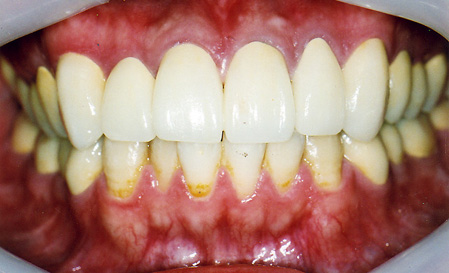
The second photograph shows the teeth without the mouthpiece. There was almost no occlusion. Only two front upper teeth touched lower teeth. Because the symptoms were constantly bothering him, he struggled with depression and quit his job.
The third photograph shows the teeth after the treatment. All upper teeth and lower back teeth were lifted up with GES crowns. Occlusion was corrected. He could now return to work with a beautiful smile.

This patient complained about jaw clicking and pain. The front upper and lower teeth do not close together, which caused an unstable bite. Also, the lower jaw was shifted to the left.
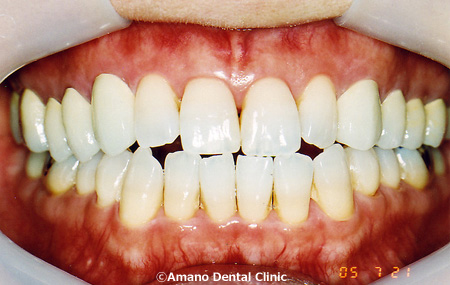
All upper back teeth and incisors were replaced with GES crowns. The entire occlusion was brought down so that the upper teeth could touch lower teeth. The jaw is now in place.
Because the bite is also realigned, the jaw clicking and pain disappeared. The front teeth, which were not replaced with GES crowns, but were whitened using Home Bleaching program. The result is a beautiful smile.